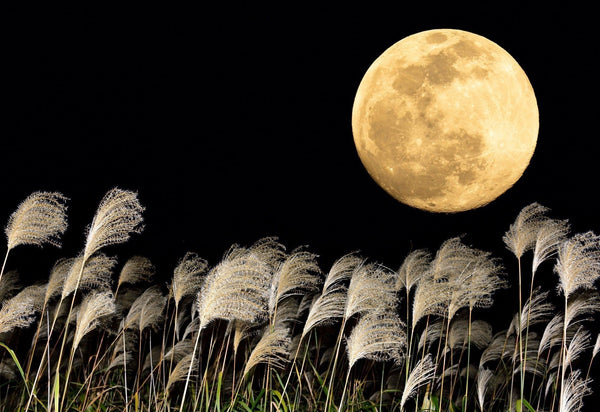
Jump to:
In case you haven’t noticed, Japanese people love to celebrate nature (like viewing the cherry blossoms with hanami, seeing the autumn leaves with momigari and watching the harvest moon with Tsukimi). This article will go into what Tsukimi is, a bit about its history, some events to check out, and more.
What Is Tsukimi?

Tsukimi (also called Otsukimi) is an event in Japan that celebrates the harvest moon (chushu no meigetsu) each year. It usually happens between September and October. Some people attend festivals to celebrate, while others stay home and gather with friends or family. People prepare traditional Tsukimi foods and make grass arrangements for the event as offerings to the moon.
For a super simple explanation of what Tsukimi is (by some adorable Japanese kids) check out this video. Bonus: According to JRRailpass.com, people also celebrate the moon in the days following the festival, too: “When the moon is not visible at festival time, celebrations are still held. They are referred to as Mugetsu or Ugetsu, meaning ‘no moon’ and ‘rain moon,’ respectively.”
When Is Tsukimi?
Well, this may be the trickiest part to explain about the holiday. The date of the mid-autumn festival isn’t always the same. That’s because it’s calculated using the lunar calendar (not the solar [Gregorian] calendar we use today). According to Osaka City Science Museum, the date of the harvest moon is August 15th on the lunar calendar. This is also called jugoya. The jugo in jugoya means “fifteen” and ya means “night.” So, it’s the fifteenth night. However, again, the 15th on the lunar calendar falls on varying dates on the normal calendar (between September and October). This year (2023) Tsukimi is on Friday, September 29th.
What Is the Harvest Moon?
To understand Tsukimi, it’s pretty important to know what the harvest moon is. If you’re not familiar with it, NASA has a good explanation: “The term ‘harvest moon’ refers to the full, bright Moon that occurs closest to the start of autumn.” And the start of autumn happens at the September equinox (aka fall equinox or autumnal equinox) — the date that both day and night are equally long. According to Live Science, “the autumnal equinox can occur anytime between Sept. 21 and 24.” So in other words, the harvest moon is the full moon closest to the date of the equinox.
Tsukimi History: It’s Like Ramen

Tsukimi has quite a long history in Japan. According to Aruhi magazine, “The culture of viewing the moon . . . was introduced from China during the Heian period [794-1185].” In China, mooncakes and watermelons were the given to the gods (one of the gods was the Chinese moon god, Chang'e). These offerings were made to give thanks for the harvest each year.
Japanese people appreciated the moon (and wanted to thank their own gods), too. So adopting this Chinese custom to give thanks for their annual harvest (along with the elegance of the ritual) fit right into Japanese culture (kind of like ramen — and many other things — that came over from China back in the day). And although the moon viewing began as an upper crust activity, it was eventually adopted by people of all classes around the Edo Period (1603-1867).
Tsukimi Tales: Legends And Lore
There are some famous stories surrounding the Tsukimi holiday. One involves a rabbit in outer space and another is about a violent Japanese moon deity. Here we go!
Moon Rabbit: Pounding Mochi in Space

This is the story of how the shape of a rabbit ended up on the moon, Tsuki no Usagi in Japanese. It’s often told around the Tsukimi holiday. An old man came from the moon and visited three animals — a fox, a monkey and a rabbit. He wanted to see which one was the most kind, so each animal offered the man a gift. The rabbit offered the greatest (?) gift of all by offering to sacrifice its own life!
The man from the moon was so impressed (wouldn’t horrified be more appropriate?) that he took the rabbit to the moon with him. After that, the rabbit’s image could be seen in the dark spots on the moon. It’s said that the rabbit is making mochi up there (perhaps this is related to Tsukimi dango — a mochi-like food for the season). Because of this story, you’ll definitely see the rabbit theme a lot in Tsukimi festivals and on Tsukimi-related items.
The Moon God: Devil’s in the Folk-Tales?

Tsukuyomi no Mikoto (also Tsukuyomi or Tsukiyomi) is the moon god (or goddess — it’s debatable) of Japan. As Unseen Japan explains, Tsukuyomi is not mentioned as often as you might expect during Tsukimi events and festivals. Why is that? Well, the Japanese moon god has a rather dark history — perhaps comparable to the story of god and the devil in the West. In this comparison, Tsukuyomi would be the devil. That’s because Tsukuyomi killed another god — the god of food (Uke-mochi) — and was forever separated from the sun. So, although there may be some who acknowledge this god or goddess during Tsukimi, most are just focused on the moon.
Tsukimi Food: From Edo To McDonald’s
There are a few popular foods made for the Japanese mid-autumn festival. Here are a few you might want to try.
Tsukimi Dango

Dango are popular pretty much all year long, but Tsukimi dango are special — mainly because of how they’re arranged. They’re put on a plate (and that plate’s often on a stand) in a pyramid shape. Perfect for a pyra-mid-autumn festival, right? You can learn how to make them with our recipe here.
Tsukimi Soba

Who doesn’t love soba? Served cold it can be perfect for the hot summer — and let’s face it — September is still hot in Japan. Tsukimi soba has an egg on it resembling the moon.
Tsukimi Udon

Another favorite noodle in Japan — udon. This dish, like Tsukimi soba, has an egg on top in honor of the moon. Some say the egg yolk is the moon and the egg white is the clouds.
Sake

Some types of sake are made just for moon viewing — like this one from Shirataki Sake Brewery. The white rabbit moon bottle it comes in is just beautiful.
Harvested Foods

Some relate the harvest moon festival to the specific foods that are being harvested — like taro, chestnuts, edamame and more. These foods are presented and eaten around the holiday, too.
Tsukimi Fast Food

This one is a bit different — you can find it at fast food restaurants like McDonald’s. The Tsukimi burger is a delicious choice, with an egg patty to represent the moon. There’s also a McDonald’s Tsukimi pie! See them both here on YouTube.
The Moon Grass Isn’t Greener
One unique part of mid-autumn moon viewing is the decoration. One of the main things you’ll see in homes and festivals (apart from the rabbit motif and Tsukimi dango) is a special Japanese grass called pampas or “silver” grass (susuki). This grass is one of the “seven herbs of autumn” in Japan (aki no nanakusa), so it has a special meaning. The susuki arrangements are used to both attract the gods and ward off evil. It also just looks beautiful with the moon.
Famous Tsukimi Festivals: So Many Places, So Little Time!

There are lots of Tsukimi festivals held throughout Japan. Here are some of the most well-known festivals happening this year.
- Himeji Castle, Hyogo - According to UNESCO, “Himeji-jo [Himeji Castle] is the finest surviving example of early 17th-century Japanese castle architecture . . .” And it's also one of the most famous places in Japan to celebrate Tsukimi. The castle will have food, music and more for the moon-viewing festival. Get more info here.
- Ise Jingu, Mie - This festival is just breathtaking with its traditional dance and music. It seriously takes you back in time to ancient Japan, because the ceremonies are so well-preserved. Ise Jingu (aka The Grand Shrine of Ise) says it’s “An elegant event where beautiful poems . . . are performed and gagaku is played on the evening of the harvest moon.”
- Mukojima-Hyakkaen Garden, Tokyo - This peaceful garden dates all the way back to the Edo period (1603 - 1867), and is apparently the oldest of its kind in Japan. According to Tokyo Cheapo, “Tsukimi at the historical Mukōjima-Hyakkaen Garden will include cultural performances such as koto playing, as well as tea ceremonies and lantern painting.”
- Tokyo Tower and Tokyo Skytree - Although no official Tsukimi events are listed this year on their websites, these are both popular places to see the moon during Tsukimi. Check them out for their spectacular views!
Not In The Moon To Go Out: Tsukimi At Home

Not feeling like going to a festival or event this year? That’s fine! You can celebrate Tsukimi at home alone — or with friends and family. The main thing you need is Tsukimi dango or some other Tsukimi-themed foods (mentioned earlier in this article). Also, if you have a window or veranda that you can see the moon from, even better! If not, you can still celebrate by eating the traditional food, drinking sake or making traditional decorations.
For the decorations, you can buy pampas grass (also mentioned in this article) at a local florist and arrange it in a container like this. Put your food and pampas grass arrangement in front of your moon-viewing area (window, veranda) and dim the lights. That’s it! You’re doing Tsukimi at home.


0 comments